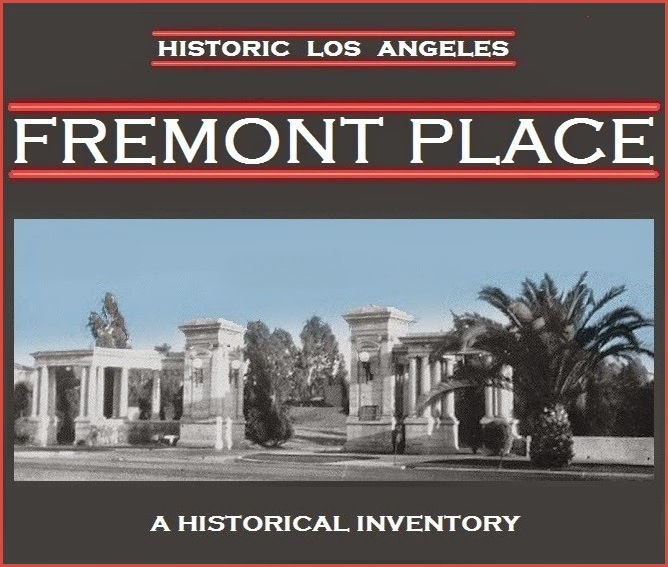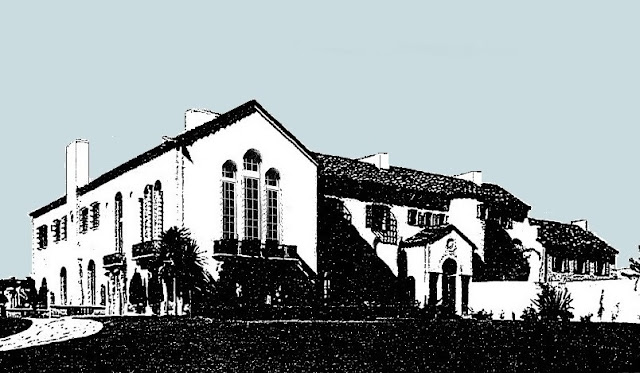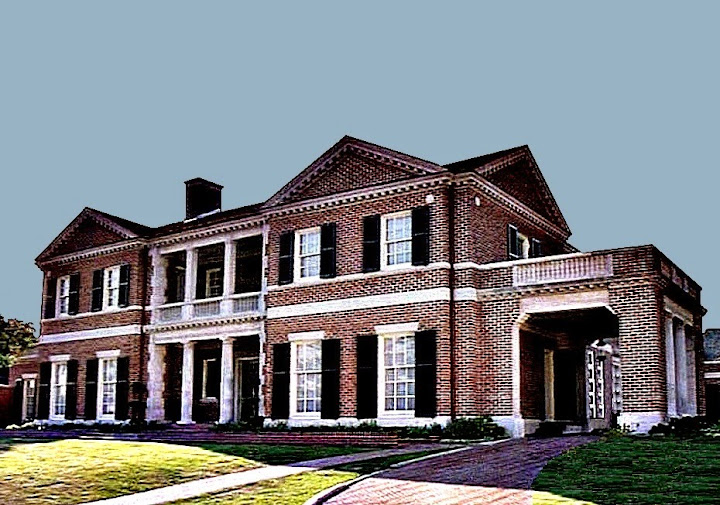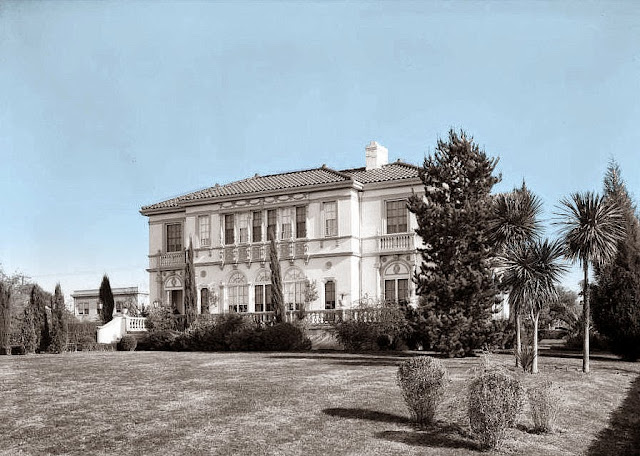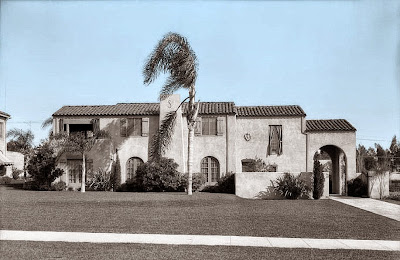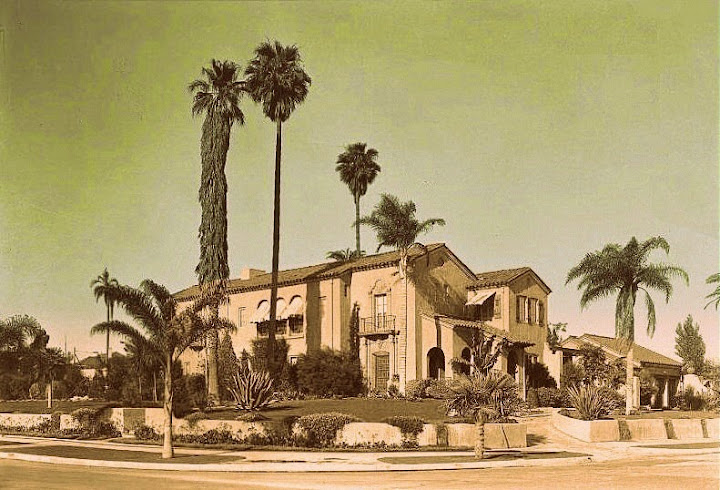"For the Man of Means"
PLEASE SEE OUR COMPANION HISTORIES
The suburban development of Los Angeles began in earnest around 1890. That year, residential Fort Street south of the Plaza in today's resurgent Downtown was renamed Broadway; its tall, narrow Victorian houses were either demolished for much taller masonry commercial buildings such as the Bradbury at Third Street or—in a practice that would be common in Los Angeles for the next 35 years—picked up and moved to new neighborhoods. While the initial push of suburbanization was to the southwest along the Figueroa Street corridor, a rival sweep of housing tract after housing tract was forming more due west of the original directional "ground zero" of Los Angeles at First and Main. The district today designated Pico-Union, for instance, saw new houses built, most often in lingering Victorian styles, among which those few of the 1880s built on Fort Street and trucked west barely stood out. Then, in 1895, Gaylord Wilshire spurred the expansion of Westlake with his famous exclusive and restriction-bound boulevard beginning on the far side of that district's namesake park, too far out to succeed, many opined. Over the next three decades, the maturing West Adams district, two miles down Figueroa and marked by an expensive establishment air amid lush vegetation, would thrive until its houses became old and its lots worth more by subdividing them during the city's wild population boom in the '20s as ever-newer suburbs began to draw the rich toward ever-extending Wilshire Boulevard—the pendulum had definitively swung northwest. By then, a dizzying number of neighborhoods were vying for the rich reconsidering West Adams. There was the westward expansion of West Adams itself, including gated Berkeley Square and the even newer Lafayette Square; there was far-flung Beverly Hills and even farther-flung Bel-Air and Brentwood; to the north, Los Feliz was also in the running. And, of course, there was always the singular allure of Pasadena.
 |
| A composite of plates from the Baist real estate atlas compiled shortly after the 1911 opening of Fremont Place and before the first house was built: The road at left—at the south end of the tract—is today Olympic Boulevard; the early designations of the two central drives were dropped in the '20s. The seven lots fronting Wilshire were mostly given addresses on that boulevard; altogether, given the competitive market for the housing dollars of the affluent of Los Angeles, many more houses than original lots were built by the early '30s. The initial hype of "in-town estates" would devolve into more of a conventional suburban tract. |
Developing in what by 1920 was being termed the "West End" of Los Angeles—as had Pico-Union and Westlake been called before—were three basic subdivisions hugging Wilshire Boulevard west of Norton Avenue. The first phase of Windsor Square—a distinct development too often today lumped with Hancock Park, which came a decade later—began to be advertised in 1911. So too that year did Fremont Place open for sales. As if the citywide competition for the title of "most exclusive" neighborhood was not stiff enough, there was a similar race among those Wilshire-adjacent developments between Norton and Highland avenues. The phases of Windsor Square were largely platted in a rectilinear fashion, more along the familiar lines of older parts of Los Angeles, including West Adams. The plan of Hancock Park included Beverly Hills–like curving streets. Neither of these subdivisions north of Wilshire, however, included pretentious gates, although such grand devices had helped Berkeley Square, for example, hang on to exclusivity longer than other parts of West Adams. When developers Charles Ingram and David Barry acquired 51 acres south of the boulevard for their ambitious tract, they saw the need to draw the attention of those motoring west out only-just-macadamed Wilshire to the left rather than to the right once they crossed Norton Avenue.
 |
The long road running at the top of the images here is Wilshire Boulevard, south of which Fremont Place lies at center of aerials taken in 1918 (above) and 1922. As pressure on housing mounted with the enormous influx of new Angelenos after the world war, property owners in West Adams sought to sell aging Victorian and early-20th-century houses at considerable profit and move from the old district to shiny new ones. Even by 1922, only about 20 houses sit in barren landscape along Fremont Place's main avenues, originally designated Easterly and Westerly drives and dotted by recent plantings. Between the drives are short cross roadways not yet connected to West Eighth, Ninth, and Tenth streets (and to which they would never actually be open to allow traffic through the Place). The new Los Angeles High School, recently opened in 1917 (at far left above and at bottom edge
below) is in place on Country Club Drive—later renamed when it became part of the route
of Olympic Boulevard—the southern border of Fremont Place. The light line running
north from the Wilshire–Westerly Drive gate in both images is Rossmore Avenue,
which divides the grid of Windsor Square from what was just developing into
the now-well-known real estate rival tract called Hancock Park to its west.
|
The Ingram-Barry tract would be christened Fremont Place, the name evoking heroic old California days to overlay its modern design of Beverly Hills–style street curves with a sort of upright establishment cred. It seems that the marketing team of Ingram and Barry might have somehow already sensed a preference among affluent homeseekers of having a kind of barrier—Wilshire Boulevard in this case—between them and imperceptibly less salubrious lands to the south. Gates would lend distinction to Fremont Place and suggest protection, exclusivity, and loftiness to those who weren't content with perpendicularity and wide-open spaces. Stately colonnaded portals—no arches or actual operating gates—rose at the Place's two boulevard entrances before a single lot had been sold, with two less elaborate designs marking the southerly ends of the main roadways. The east boundary of the subdivision was a half-block west of Burck Place, subsequently renamed as an extension of Lucerne Boulevard; the west line was a half-block east of Muirfield Road. The two main drags were Easterly Drive and Westerly Drive, designations that faded in the '20s in favor of "Fremont Place" and "Fremont Place West." With Wilshire its northern boundary, at the south was Country Club Drive, leading directly from the Country Club District—another glamorous, but ultimately largely unsuccessful, contender for rich homeseekers. Country Club Drive was later brought into alignment with Olympic Boulevard, where the third and fourth gates of Fremont Place remain today, closed to traffic and the dropoff in neighborhood desirability the south.
 |
| This lower altitude view from more or less than same perspective as the broader bird's-eye above was taken 50 years later; numbers 53, 55, and 61 Fremont Place appear at the lower edge from right. |
In the fall of 1911, display ads began to appear in the Los Angeles Times offering "The most exclusive and highest class residence community in the most desirable residential city in America—Fremont Place." Ingram and Barry gushed further: "There is no other residence property in Los Angeles to compare with it—no property which gives the man of means such opportunity for exclusiveness—such unique home attractions." Then came the real sales pitch: "Considering its character, its elegance—the prices at which this property is obtainable are exceedingly low. Because of its extremely high character—the property is necessarily limited—and those who wish to secure a homesite here must avail themselves of the opportunity at once." There would, in fact, be quite a bit of interest but no mad rush of "men of means"; it would be nearly three years before the first house was built. Particulars included the tract's division into "48 large roomy lots, with broad, petrolithic pavement, 22-foot parkings, 7-foot sidewalks—beautiful ornamental trees." With the entire "West End" actually little more than prairie, it would be a while before the trees provided any shade or beauty. It is surprising, when one thinks about it, how many men of means and their families were willing to put up with little natural vegetation and only sparse settlement for as long as they did. It wasn't until the late '20s that Windsor Square, Hancock Park, and Fremont Place would even begin to have the lush Garden District–like charm that many would be leaving behind in old West Adams. But then, whether you were rich or poor, Los Angeles was all about the new.
NOTE: Fremont Place: A Historical Inventory is a work in progress; the links below under illustrations of each address lead to house histories in various stages of completion.
 | |
A large advertisement for Fremont Place appeared in the Los Angeles Times on October 8, 1911; on the same day, a rendering of its main gates designed by architect J. Martyn Haenke, depicted below in their original configuration and patterned after those of Berkeley Square, which David Barry saw every day from his Gramercy Place house, also appeared. While described by promoters as granite, the gates were actually of cast concrete treated to resemble the more luxurious material. Two more portals stood along Country Country Club Drive (a stretch of road now aligned with Olympic Boulevard) at the south end of the tract. All four gates remain, less their sweeping colonnades incorporating pedestrian entrances. |
 |
| The west gate as seen from inside Fremont Place on April 21, 1956: The connecting colonnades that formed the pedestrian entrances are gone by now, thought by some to have been removed after the destabilizing effects of the Long Beach earthquake of 1933. At right is the fabled Barnett house at 644 South Rossmore Avenue. |
31 Fremont Place: The Solomon and Amy Hellman Aronson House

49 Fremont Place: The Jack L. Maddux House
50 Fremont Place: The Judge Myron Westover House
53 Fremont Place: The Shultz / Rhinock / Croft House
55 Fremont Place: The Martin Mosier / Muhammed Ali House
56 Fremont Place: The Mathewson / Pickford / Minter / Howard House

60 Fremont Place: The Harry F. Brown House
61 Fremont Place: The Orendorff / Gates / C. W. Crawford House
62 Fremont Place: The Woods / Young / O'Connor House

63 Fremont Place: The Martin Winkler House
64 Fremont Place: The William Johnson / James Thomas Holmes House

65 Fremont Place: The Alfred D. Davey House

66 Fremont Place: The Samuel Tilden Norton House
68 Fremont Place: The John S. Shepherd House

69 Fremont Place: The Warner / Stebbins / Comegys / Bassett-Vance House
70 Fremont Place: The James and Fanny Wilcox Drake House

71 Fremont Place: The Dalton / Scott / Ward House
73 Fremont Place: The Nels Gross House
74 Fremont Place
CLICK HERE FOR FULL STORY

75 Fremont Place: The Harvuot / Signor / Macmillan / Nix / LaBelle House
CLICK HERE FOR FULL STORY

76 Fremont Place: The Beverly Bolling McCollum House
CLICK HERE FOR FULL STORY
77 Fremont Place: The Look / Schwartz / Vance House
CLICK HERE FOR FULL STORY

78 Fremont Place: The Forest H. Gillespie House
CLICK HERE FOR FULL STORY

81 Fremont Place: The Koehler / Kingman House
CLICK HERE FOR FULL STORY
CLICK HERE FOR FULL STORY

75 Fremont Place: The Harvuot / Signor / Macmillan / Nix / LaBelle House
CLICK HERE FOR FULL STORY

76 Fremont Place: The Beverly Bolling McCollum House
CLICK HERE FOR FULL STORY
77 Fremont Place: The Look / Schwartz / Vance House
CLICK HERE FOR FULL STORY

78 Fremont Place: The Forest H. Gillespie House
CLICK HERE FOR FULL STORY

81 Fremont Place: The Koehler / Kingman House
CLICK HERE FOR FULL STORY
82 Fremont Place: The Edwin A. Meserve / Dr. Richard Dillon House
CLICK HERE FOR FULL STORY
CLICK HERE FOR FULL STORY

83 Fremont Place: The Julius K. Hornbein House

84 Fremont Place: The Mary C. Demond House
85 Fremont Place: The Adolph and Bertha Sieroty House

86 Fremont Place: The Alexander E. Newman / Oscar Trippet House
87 Fremont Place: The Sylvester L. Weaver Jr. House

89 Fremont Place: The Viall / Day / O'Neill House

90 Fremont Place: The Cortland R. Myers House

91 Fremont Place: The Philip B. Kennedy House

92 Fremont Place: The Lloyd Coleman Young House
CLICK HERE FOR FULL STORY

93 Fremont Place: The Raymond C. Moore House
CLICK HERE FOR FULL STORY
94 Fremont Place: The Warren B. Bovard House

95 Fremont Place
96 Fremont Place: The Samuel and Cecelia Markowitz House
97 Fremont Place: The Martha Chapoton House
98 Fremont Place: The Smith / McAfee / Robbins House

99 Fremont Place: The Irvin Kaiser House
100 Fremont Place: The Thompson / Gillette / Archdiocese / Barham House

101 Fremont Place: The David A. Mizener / William H. Daum House
104 Fremont Place: The Charles J. Wild / D. Coy Burnett House
107 Fremont Place: The Hart / Craig / Amacker House
108 Fremont Place: The E. Clement Wilson House

109 Fremont Place: The George W. Walker House
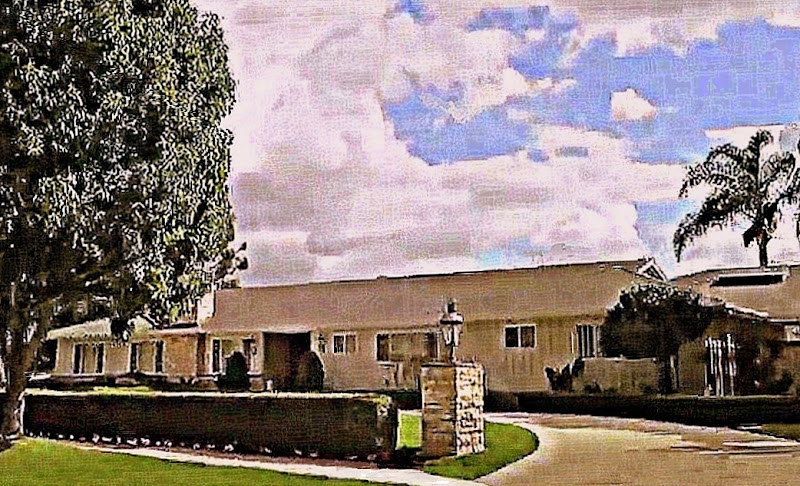
112 Fremont Place: The Addison and Lenora Harth House

113 Fremont Place: The Charles Hollenbach House
114 Fremont Place: The Jones / Hole / Rindge House

115 Fremont Place: The David N. Barry House

117 Fremont Place: The Marie Dawson / Bertha McCue House
118 Fremont Place: The Howell N. Baker / James W. Fifield House
119 Fremont Place: The Frank E. Horne House

120 Fremont Place: The Wotkyns / Wilson / Knight / Christy / Parks House

121 Fremont Place: The Walter J. Reynolds House

122 Fremont Place: The Henry L. Gilbert / Dr. Joe Zeiler House

123 Fremont Place

124 Fremont Place: The George F. Hambright / Harry Tristram Coffin House

125 Fremont Place: The Klein / Wilkins / C. M. Crawford House

126 Fremont Place: The Edward C. English / E. Eric Larson House

127 Fremont Place: The Vincent R. Lamia House

128 Fremont Place: The Benjamin Harwood House
129 Fremont Place: The Carter / Pickford / Day / Rude House
132 Fremont Place: The George Henry Letteau House

133 Fremont Place: The Martin L. Houseman House

134 Fremont Place: The John Crombie Niven House
135 Fremont Place: The Harry Cohn / Peter Bart House
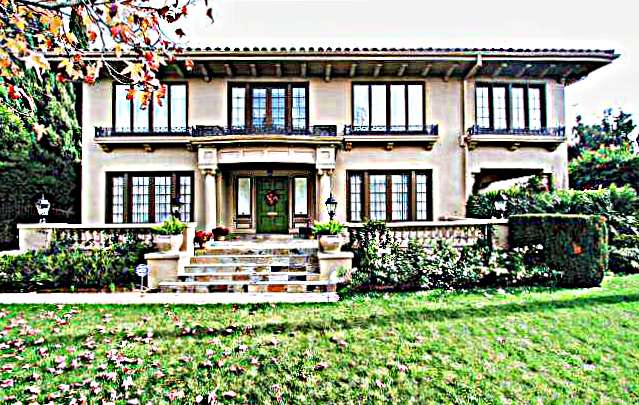
136 Fremont Place
Illustrations: LAT; Historic Map Works; USCDL; LAPL; Larchmont Buzz;
others credited in individual posts
